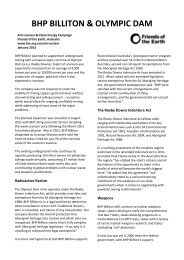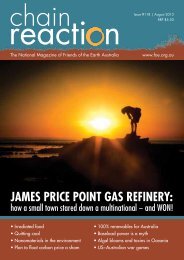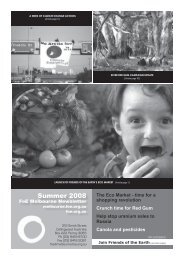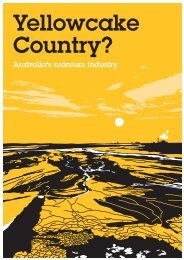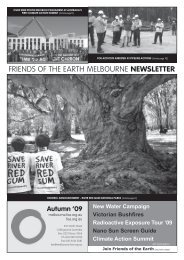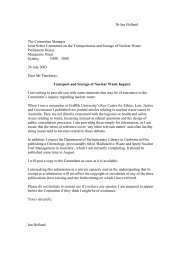Thirty Years of Creative Resistance - Friends of the Earth Australia
Thirty Years of Creative Resistance - Friends of the Earth Australia
Thirty Years of Creative Resistance - Friends of the Earth Australia
Create successful ePaper yourself
Turn your PDF publications into a flip-book with our unique Google optimized e-Paper software.
change. Mark Carter, co-founder <strong>of</strong> <strong>the</strong><br />
Food Justice Centre, and Leigh Holloway<br />
oversaw production <strong>of</strong> a magazine, which<br />
carried a lot <strong>of</strong> big picture strategic debate,<br />
with sharp layout and <strong>of</strong>ten striking covers.<br />
Some <strong>of</strong> <strong>the</strong> most inspirational inserts and<br />
editions date from that time.<br />
Under <strong>the</strong> editorship <strong>of</strong> Mark and Leigh<br />
and, slightly later, Linnell Secomb,<br />
CR continued its evolution towards an<br />
emphasis on social issues. Cover stories<br />
included food politics, workers’ health,<br />
women’s employment in <strong>the</strong> service sector<br />
and jobs in Wollongong. But <strong>the</strong>re were<br />
clearly still differing perceptions <strong>of</strong> <strong>the</strong> role<br />
<strong>of</strong> <strong>the</strong> magazine.<br />
At this time, Christina Melaluka <strong>of</strong><br />
International Development Action in<br />
Melbourne commented, “CR is <strong>the</strong><br />
environment magazine that cares about<br />
people. They are concerned about trees<br />
because <strong>the</strong>y are important for <strong>the</strong> wellbeing<br />
<strong>of</strong> people, not just for <strong>the</strong> tree’s own<br />
intrinsic value, like so many greenies”.<br />
However, this strong sense <strong>of</strong> direction<br />
appears to have been a significant<br />
problem for a magazine that was meant to<br />
be produced on a collective basis, while<br />
also acting as <strong>the</strong> ‘mouthpiece’ for FoE in<br />
<strong>Australia</strong>.<br />
The recognition <strong>of</strong> CR as a service<br />
organisation seems to have been an<br />
attempt to resolve <strong>the</strong>se tensions about<br />
<strong>the</strong> magazines role.<br />
In later years FoEA clarified <strong>the</strong> fact<br />
that while CR was <strong>the</strong> ‘flagship’ FoE<br />
publication, it also had great value as a<br />
‘movement’ magazine and hence should<br />
continue to run ‘outside’ material and<br />
perspectives ra<strong>the</strong>r than just being a<br />
propaganda machine for FoEA.<br />
However, in <strong>the</strong> early 80s, <strong>the</strong>re were<br />
considerable differences <strong>of</strong> opinion about<br />
CR. Denise Chevalier wrote in 1982 that<br />
significant national issues, especially<br />
nuclear concerns, were being “ignored”<br />
by <strong>the</strong> ‘main anti nuclear magazine in<br />
<strong>Australia</strong>’ and she took <strong>of</strong>fence at <strong>the</strong><br />
“Marxist rhetoric” <strong>of</strong> a cover story on<br />
Wollongong.<br />
...................................................................................................................................................................................................<br />
In 1982, a CR ‘consultative group’<br />
composed <strong>of</strong> representatives from local<br />
groups was created to provide advice on<br />
<strong>the</strong> magazine as well as to find ways to<br />
increase frequency and consider changes<br />
to format and layout <strong>of</strong> <strong>the</strong> magazine.<br />
With issue #29 (Spring 1982), <strong>the</strong>re was a<br />
serious disagreement within <strong>the</strong> editorial<br />
collective over both design issues and <strong>the</strong><br />
cover story, an article on <strong>the</strong> ‘resource<br />
boom’ which was creating casual and<br />
poorly paid jobs for women in <strong>the</strong> service<br />
sector.<br />
Chain Reaction has been produced by<br />
an independent editorial collective, which<br />
has been based in various cities including<br />
Adelaide, Canberra, Melbourne and<br />
Sydney.<br />
It was mostly based in Melbourne from its<br />
creation in 1975 until early 1989 when it<br />
moved to Adelaide.<br />
It was formally recognised as a service<br />
organisation <strong>of</strong> FoEA in 1982 following<br />
conflict over <strong>the</strong> function and role <strong>of</strong> <strong>the</strong><br />
magazine.<br />
Image from Chain Reaction<br />
FoE 30 <strong>Years</strong> 121



